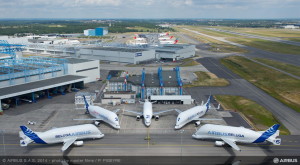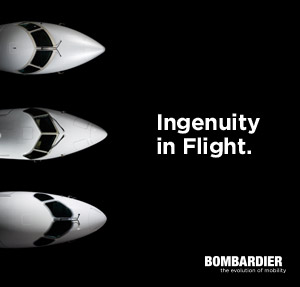Beluga celebrates the 20th anniversary of its first flight
Written by thomas · Filed Under Aeronautics NewsSeptember 12, 2014
Flight hours per aircraft have since doubled and will do so again by 2017
With its maiden flight on September 13, 1994, the popular Beluga cargo aircraft, affectionately named after the white whale because of its remarkable shape, is celebrating this week twenty years of transporting Airbus component parts between Airbus’ European manufacturing sites.
Since 1995, the fleet of five Beluga aircraft replaced the ageing Super Guppy transporters in order to supply the Airbus final assembly lines in Toulouse and Hamburg. Today, more than sixty flights are performed each week between eleven sites, carrying crucial parts for all of the Airbus programmes, including the A380*.
The Beluga fleet is operated by Airbus Transport International (ATI), an Airbus subsidiary airline, and each Beluga crew is composed of a pilot, a co-pilot and a flight engineer.
With the production start of the A350 XWB in 2012 and the production ramp-up on other Airbus programmes, the Beluga activities again will substantially increase over the next five years.
In order to accompany this challenge, Airbus launched in 2011 the Fly 10 000 project. Flight crew numbers and flight hours have grown and loading procedures have been further optimized, with the opening of new integrated loading facilities in Hamburg and Bremen in Germany and Saint-Nazaire in France. Broughton, UK and Getafe, Spain will follow soon. Fly 10,000 should allow the Beluga fleet to double its activities by 2017 (from 5,000 to 10,000 flight hours).
“The Beluga is an essential element of Airbus’ integrated logistics and production system. It is thanks to its reliability and engagement of the Beluga teams that we can fulfil our constant pursuit of efficiency”, said Günter Butschek, Airbus Chief Operating Officer.
The Beluga is based on the twin-engine A300-600R, appreciated for its reliability and its cost-effectiveness. It is powered by General Electric CF6-80C2 engines. With its impressive dimensions (56 m long, 17 m high, a fuselage diameter of 7.71 m and a main-deck cargo volume of 1,400m3), the Beluga is the champion of its category (compared with the Antonov AN-124 or even the C-17). The Beluga can carry a maximum payload of 47 metric tonnes non-stop over a range of 1,660 km/900 nm.
*only the Vertical Tailplane and tailcone, all other A380 components being transported through the “multimodal transport system (sea, river, road).

» Próximo Post - Revista Aerea – agosto/setembro 2014
« Post Aneterior - Frasca Full Flight Simulator Receives Level D Approval
Comments
¿Tiene algo que decir?
You must be logged in to post a comment.







